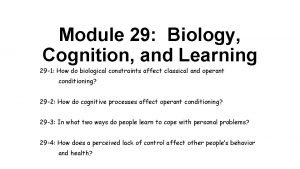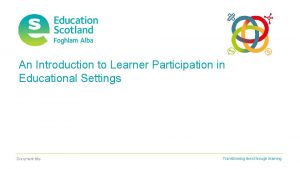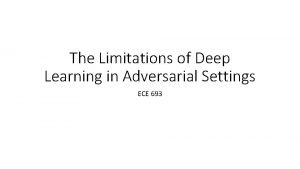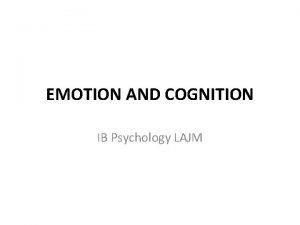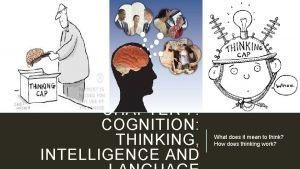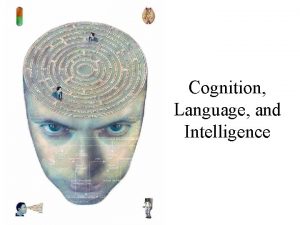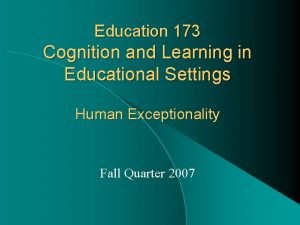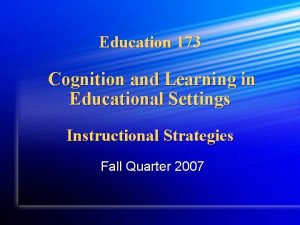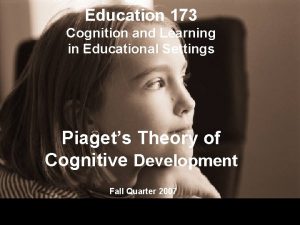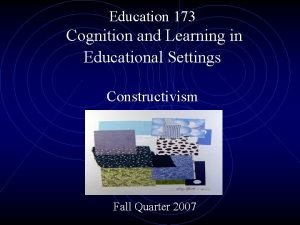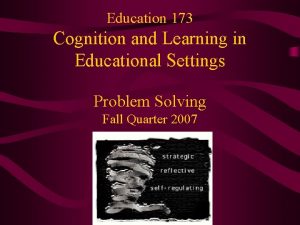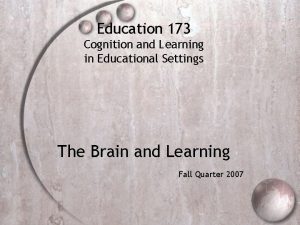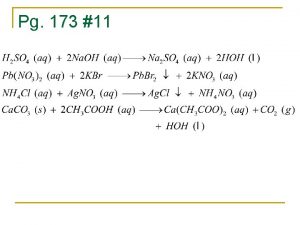Education 173 Cognition and Learning in Educational Settings









- Slides: 9

Education 173 Cognition and Learning in Educational Settings Cognitive Processes Fall Quarter 2007

Cognitive Processes and Cognitive Structure We Can Understand Cognitive Processes, Such As. . . – – Learning Remembering Perception Attention . . . In Terms of Information Flow Within the Cognitive Structure – Working memory – Long-term memory

Perception Dividing and Organizing the Sensory Field – Visual People, objects; Figure and ground – Auditory Speech is a continuous sound stream Top-Down & Bottom-Up Processing – Bottom-up begins with sensory details – Top-down begins with expectations derived from prior experience Perception Creates Meaningful Units (Chunks) in Working Memory

Attention Processing Some Information Filtering Out Other Information – Example: Cocktail party phenomenon Influenced By – Goals – Prior knowledge Attention is Gateway to STM (WM) Implications for Teaching – You must have students’ attention; otherwise, no learning (LTM change) Attending Means to Hold Information in Working Memory

Encoding Type I Encoding: Rehearsal – Simple repetition – Rote learning (not meaningful) – Write Time from WM to LTM: About 10 seconds per chunk Type II Encoding: Elaborative Encoding – Making meaningful connections Learning/Encoding STM/ WM LTM Retrieval/Recalling

Encoding Specificity The Context for Learning (Encoding) Affects Retrieval Examples of Encoding Specificity – Physical context Baddeley’s scuba study – Emotional context Bower’s experiments – Semantic (meaning) context Example Source: : http: //intropsych. mcmaster. ca/intropsych/1 a 3/Cognition/lec 2 -2. h

The Serial Position Curve Primacy and Recency Effects Interference – Proactive near the end – Retroactive near beginning – Both where? Value of Curve for Teaching? – The beginning and end of a lesson are crucial – Try to reduce informational distractions before and after learning, and so create primacy and recency effects

Forgetting Several Possible Explanations – – – Decay Inadequate Retrieval Cues Reconstruction Error Adding plausible but incorrect information to the memory Can be influenced by “leading” questions Eyewitness testimony Is Forgetting Adaptive? – Zeigarnik effect-- “flushing” – Eidetic memory Extremely rare Not necessarily adaptive

 Module 29 biology cognition and learning
Module 29 biology cognition and learning Learner participation in educational settings
Learner participation in educational settings Learner participation in educational settings
Learner participation in educational settings The limitations of deep learning in adversarial settings.
The limitations of deep learning in adversarial settings. Chapter 7 cognition thinking intelligence and language
Chapter 7 cognition thinking intelligence and language Emotion and cognition ib psychology
Emotion and cognition ib psychology Cognition thinking intelligence and language
Cognition thinking intelligence and language Does language reflect intelligence
Does language reflect intelligence Cognition and personalization
Cognition and personalization Cuadro comparativo e-learning y b-learning
Cuadro comparativo e-learning y b-learning
